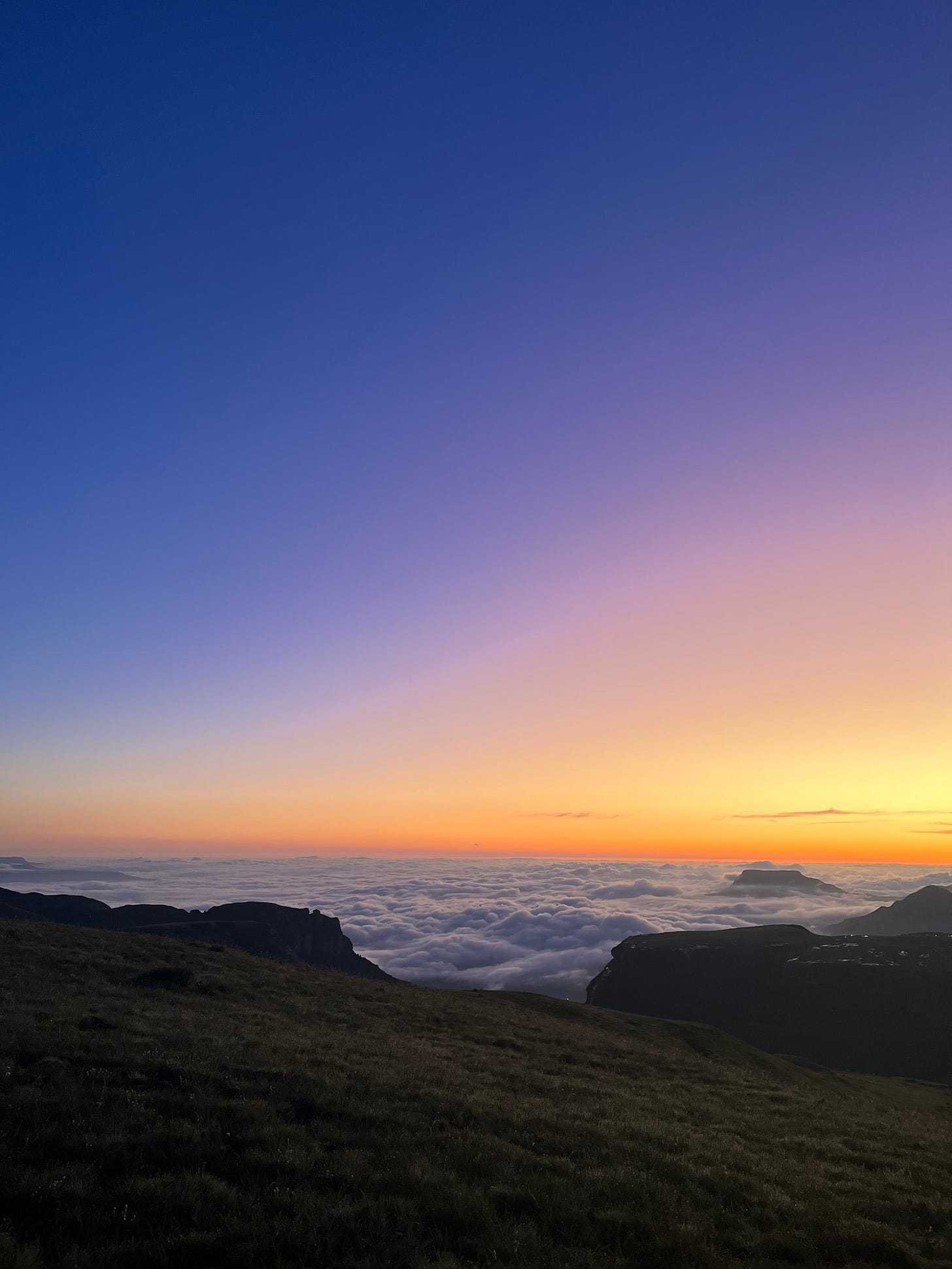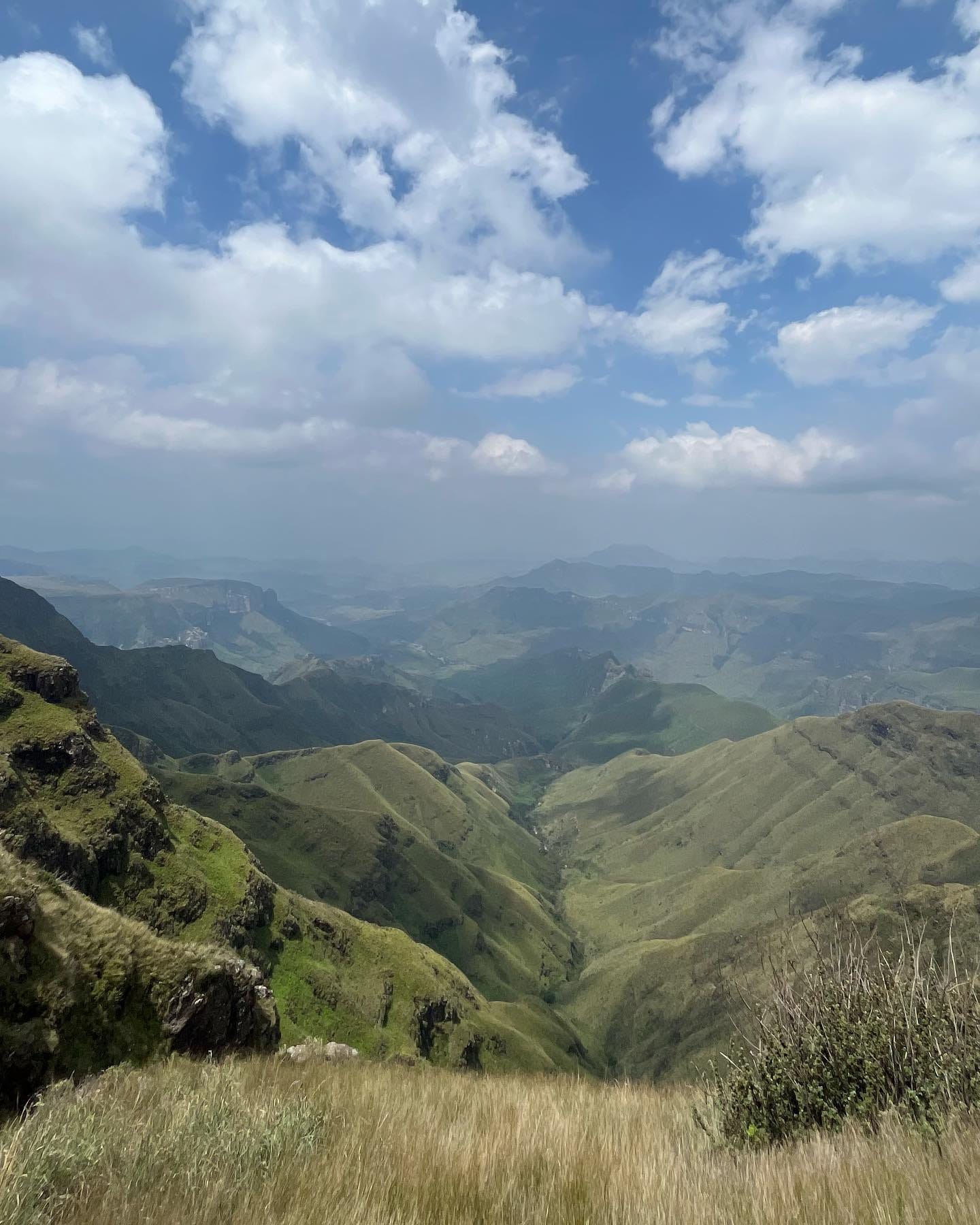On finding awe at the mouth of Tugela falls
Standing at the mouth of Tugela falls. Photo: Aina J. Khan.
The Tugela falls are located in the northern Drakensberg mountains in South Africa. With an uninterrupted leap of 1,350 feet, and a total drop of 3,110 feet, Tugela, is now the world’s highest waterfall.
My journey to Tugela began late at night as I was driven to Witsieshoek lodge by an Afrikaner couple, Barry and Elizabeth, after spending a few days in Lesotho, a land-locked country inside South Africa of verdant green mountains and waterfalls spilling from every peak.
Craning my neck at the rear window behind me as the two spoke about the impact of the coronavirus pandemic on tourism in South Africa, I watched in awe as shooting stars hurtled across a night sky carpeted with stars like streaks of glistening white thread.
At 4am the next day, the rising sun woke me from my sleep because my entire room and the horizon was ablaze in a red light that came streaming through the frosted window of my hotel room. Still in my silk pyjamas, I scrambled into my puffer jacket and hat and ran outside to film pink skies and plumes of clouds surrounding the mountain lodge nestled in the Drakensberg mountains.
Sunrise over Witsieshoek mountain lodge in South Africa. Photo: Aina J. Khan.
Three hours later, with my guide Mo leading the way, I began my ascent.
After a few hours watching baboons leap over foggy ledges, walking through bushels of yellow chrysanthemum flowers, and being enveloped in sun and suddenly dense mist that came and went as though a giant were motioning blankets of mist in our direction with a sway of its hands, in the end, I reached the mouth of Tugela.
Standing at the beginning of five waterfalls that branch out into the warmth of the Indian ocean, it was almost completely blanketed by thick mist.
My legs trembled with terror as I stood there, humbled by its titanic size and its power coursing through crystal clear waters untouched by the pollution that has crept into South Africa’s spectacular rivers and beaches.
With so much in life, we want to see the fruits of our labour, something tangible that we can name and touch so we can declare to someone or to our own egos maybe, that we’ve done something worthy.
Surrounded by swathes of cloud-like mist, a vibration in the air diffused into my skin, giving me a sense of how terrifyingly high I was standing. I didn’t need to see the waterfall drop, to feel the majesty of the place I had climbed to.
A view of the first waterfall of Tugela falling over a thousand feet. Photo: Aina J. Khan.
If you Google “Tugela falls hike,” you will almost certainly find blog posts about the notorious chain ladders on a cliff face leading up to the falls with nothing to catch you if you fall.
Depending on which route you take, you cannot reach Tugela without climbing up or down the chain ladders. I did climb down, gripping each handle for dear life as I took small baby steps down the rungs, my eyes transfixed onto the cliff in front of me.
Nobody told me that I would feel terror so keenly when I hit my thirties. I feel it, often, and I certainly felt it on those chain ladders. But awe and terror it seems, are opposites and bed fellows.
One of the notorious chain ladders at the Tugela falls hike. Photo: Aina J. Khan.
According to the Merriam-Webster dictionary, awe is defined as, “an emotion variously combining dread, veneration, and wonder that is inspired by authority or by the sacred or sublime.”
In an interview with The Washington Post, the American psychologist and professor, Dacher Keltner, who has spent years studying the beneficial effects of awe on our physical, mental and emotional well-being, described awe as something that “makes us curious rather than judgmental.” Awe, he adds, “makes us collaborative. It makes us humble, sharing and altruistic. It quiets the ego so that you’re not thinking about yourself as much,” Keltner said in the interview.
Today, I am 32.
The older I get, the more I want to cling on to that child-like awe that has gently tugged at me all my life, urging me to be brave, to seek beauty and joy in spite of loss, to love in spite of rejection, to seek change, to be humbled and learn from the many people I meet, and to travel beyond the rigid borders created by my imagination and society at large, even though terror grips its claws at my throat.
Adulthood has nurtured the opposite of awe I think, and instead nudged forward a pathetic, feeble outlook on life that keeps many of us stuck in a well of pessimism, blinding us to the joys of life.
Awe is what keeps our eyes open to the stars shooting across the night sky; the selfless generosity of elderly women who embrace the generations below them as their own; the families who open their home to strangers to nurture community where loneliness is pervasive; the nine-month old girl gazing at the world hurtling by on her first train ride; the blossoming feeling after a first kiss; and the scent of freshly baked scones that forever reminds me of my mum’s love for her children.
Awe is connection. Awe is healing. There is a profound humility in the realisation that there are things out there that are so much larger than the orbit of our own lives.
Ultimately, awe, I think, is an indication of our love and hunger for life: both its exceptional beauty, and conversely its beautiful mediocrity.
I have one less year to live, and another to welcome.
I hope my eyes and my heart are never closed to the veneration, joy and surprise that spilled out of me when I was a school girl, day dreaming about whales gliding past my window in Shepherd’s Bush, Peter Pan offering me a glass of Sun Pride tropical juice to help me to fly, seeing the world for myself, and catching all the Pokémon that ever existed.
The spectacular Drakensburg mountains. Photo: Aina J. Khan.








